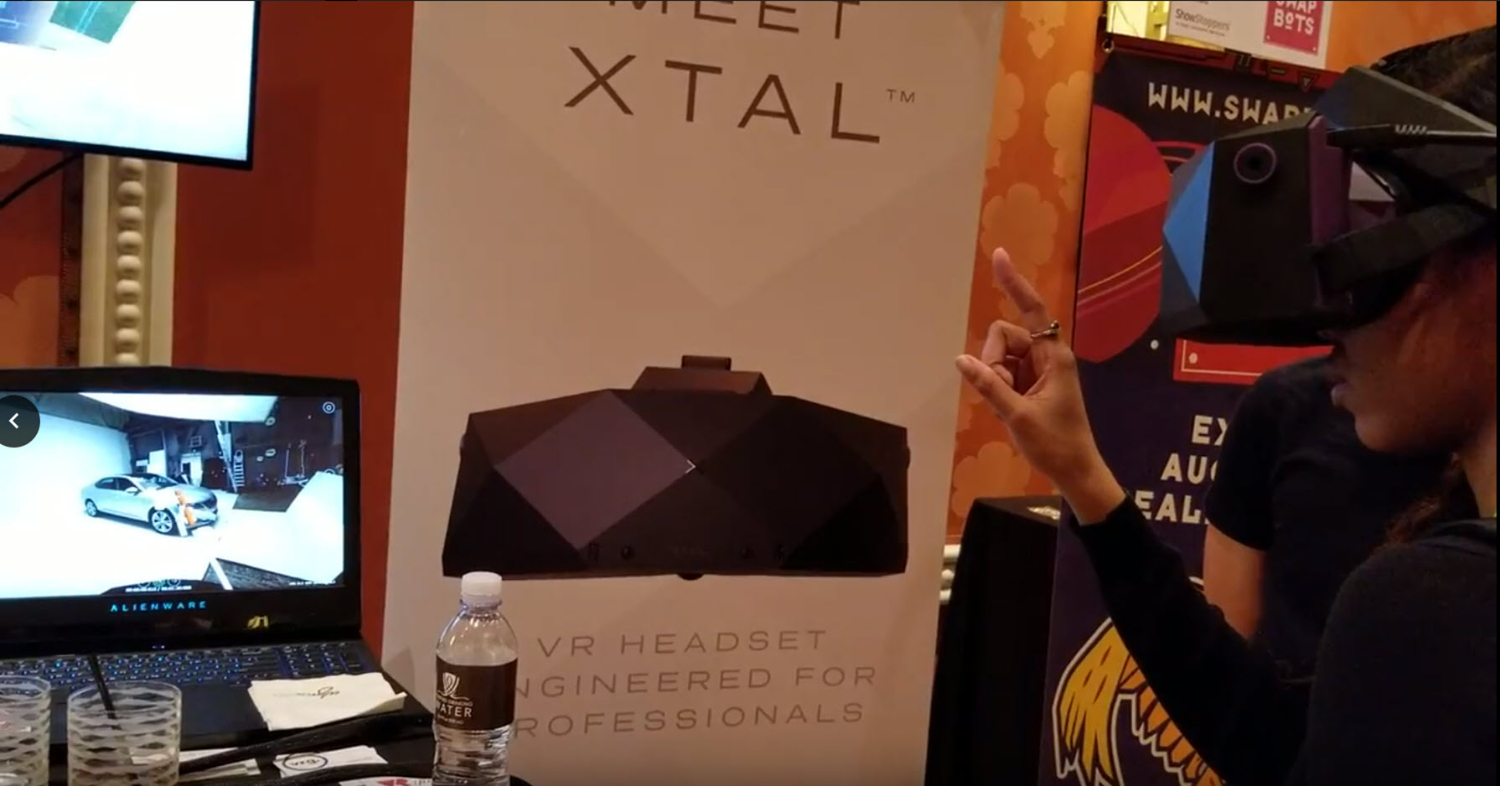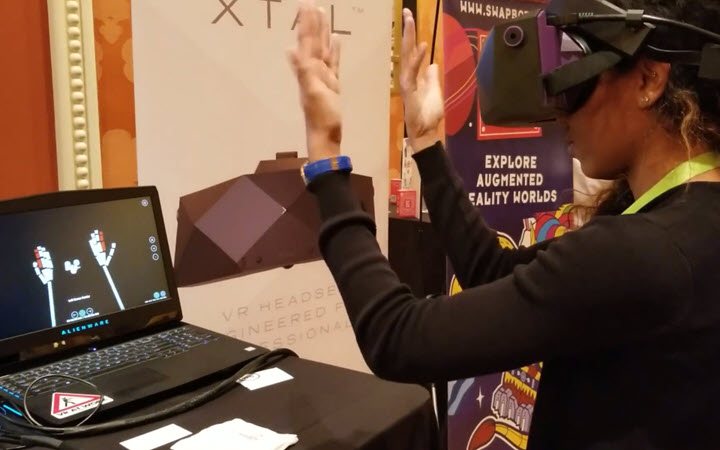$6,000 XTAL Headset Has What VR Needs: Hands-On
A realistic, beautiful display, an impressive 180-degree field of view (FOV) and game-changing, controller-free hand usage in VR. XTAL, VRgineers’ $6,000 VR headset, has so much of what we hope for in consumer VR.
XTAL VR Headset Specs
| Screen | OLED, non-Fresnel |
| Resolution | 2560x1440 per eye |
| FOV | 180 degrees |
| Refresh Rate | 70Hz |
| Included Software | Headset Configuration UtilityUnreal Engine SDKUnity 3D SDKXTAL C++ Libraries for proprietary render engine integration (optional) |
| Dimensions (HxWxD) | 299 x 123 x 140 mm (11.8 x 4.8 x 5.5 inches) |
| Weight | 770g (1.7 pounds) |
| Price | $6,000 |
Yes, XTAL is a pricey piece of tech at $6,000. But note that XTAL, which just started shipping this month, is targeting enterprises. Think cost-efficient virtual prototyping, architecture and racecar driving. When we met with VRgineers at CES in Las Vegas this week, we saw animation for an amazing looking helicopter piloting simulation that seemed like a real trip, although it wasn’t available for demo.
XTAL is compatible with SteamVR, so you could technically use it for gaming as its compatible with SteamVR. They say optimal hardware setup varies based on what software you’re using, but for a standard setup, you’d need a PC with Nvidia GeForce GTX 1080 Ti or better graphics card. Plus, you’d have to use controllers, taking away my favorite feature of the headset.
My demo was a bit limited, comprised entirely of static, real-life photos with very limited virtual interaction. I used XTAL’s integrated hand tracking to navigate through a series of virtual environments. Without even needing to calibrate, my hands were completely usable in the virtual world. Appearing as a skeleton, I could move my arms and individual fingers and push buttons to take me through the various environments. Of course, I had to find out how well the embedded Leap Motion 2.0 hand tracking sensors could keep up. It did pretty well, acknowledging me forming fists, waving my hands back and forth and doing a thumbs-up in what felt like real-time. It couldn’t handle the Vulcan salute though.
The XTAL headset uses VRgineers’ homegrown lenses with 2560x1440 resolution in each eye for a 5K total. Unlike most consumer VR headsets, XTAL uses non-Fresnel lenses. Meanwhile, OLED displays are said to bring truer blacks, more rapid switching between colors, low latency and blur reduction. With a wide, 180-degree FOV, I could see details in my peripherals. When transported into a busy city, I saw golden streaks representing speedy cars out of the corner of my eyes.
The headset has an faux leather face cushion, which was quite soft and comfortable. XTAL weighs 1.7 pounds, 0.3 pounds more than the Oculus Rift or HTC Vive Pro, so I definitely felt the gentle weight of it on me, but it wasn’t overwhelming.
Like the upcoming HTC Vive Pro Eye announced this week, XTAL also has integrated eye tracking. However, while HTC’s headset will use eye tracking for in-application use, XTAL’s is only for setting the user’s interpupillary distance (IPD).
Get Tom's Hardware's best news and in-depth reviews, straight to your inbox.
Will There Be a Consumer XTAL VR Headset?
You’re probably thinking, “this is cool, but will I ever be able to buy this?” Well, the XTAL headset was made for businesses. And although individual consumers can buy XTAL online, $6,000 is a lot to shell out and thousands more than any other consumer VR headset. There’d have to be some work done to make XTAL more realistic for consumer pockets and use cases, like gaming. Part of doing the latter would also have to include upping that 70Hz refresh rate to compete with the 90-Hz Rift or HTC Vive.
But there’s hope. VRgineers co-founder Martin Holečko told Tom’s Hardware during CES that the company is open to licensing their technology to someone who could build the headset for VR gaming.
Don’t expect VRgineers to make an XTAL gaming headset themselves though. “We don’t want to fight with the big guys,” Holečko said.

Scharon Harding has over a decade of experience reporting on technology with a special affinity for gaming peripherals (especially monitors), laptops, and virtual reality. Previously, she covered business technology, including hardware, software, cyber security, cloud, and other IT happenings, at Channelnomics, with bylines at CRN UK.
-
KD_Gaming Why so you need to wait 5years and spend $2k on graphics to run something basic on it? You can't just up the resolution nadhir. You have to take current tech into consideration. Not to mention a dual 8k res screens would cost you like 20k per screen... if they even existed at that size.Reply -
mebalzer There is no reason for this to cost so much, other than you know from the beginning you won't sell very many. There is nothing in the specs that denote better performance other than the higher resolution, which is done with two 2560x1440 OLED smartphone panels and a custom lens which probably cost $200-$300. The fact the framerate of 70Hz reflects what most standard phone panels can achieve, and you only have 3DOF with hand tracking provided by either Leap Motion or Fingo which you can attach to any HMD for hand tracking for less than $100, makes this seem like an extremely expensive HMD that you could buy three Vive Pros for, or if you are willing to wait 90 days, several PiMax 5K + with actual controllers.Reply
However it would be cool though if they offered their lens design as aftermarket product for other headsets. -
justin.m.beauvais It is an interesting tech demo, that is for sure. However I don't quite think that LeapMotion is going to be the way forward for hand tracking. Yes it is cool, and I even want to get one, but Google's new low power radar tracking would make for a much more interesting tracking solution. With embedded sensors in the headset and a tracking base on the desk you could get extremely fine full body movements. The 180 degree FOV is pretty darn impressive as well, and is something that should have been a goal since day 1.Reply
I think that VR has a ways to go before it is really ready with everything up until now being pretty much public beta testing. That isn't to say that VR isn't fun and really cool to play with, I have a WMR system and love the heck out of it. I just think we have quite a bit in the realm of refinement before VR is everything we've ever wanted, and this makes for an interesting step in the right direction. What isn't a step in the right direction are these stand alone cell phone based "solutions" and such. I know that getting people interested in VR is a necessary step, but showing them a dumbed down experience isn't going to win many followers.
Current headsets need a price drop to get reasonable headsets into the hands of users and makers need to swing for the moon with new designs. Conservative designs aren't going to win supporters. The thing with VR is that it is all or nothing. You either have an immersive experience, or you have a fancy box you strap to your face that is just a really close 3D monitor. I can't tell you how often the controllers get in the way, or the headset slides around, or I snag my earbuds and pull them out, or I snag the headset cable. All those things break immersion. The current displays are fine as long as you aren't looking for the screen door (I never notice the screen door in games, but I do on the desktop), but everything else is cobbled together and kludgy. I know there are some solutions out there for some of these, but I travel a lot so some of them just won't work for me (hence the WMR, no tracking stations). Eventually someone will have to get it right, or VR won't survive.

